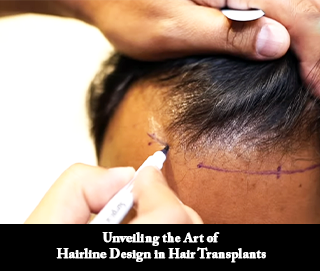Unveiling the Art of Hairline Design in Hair Transplants

The road to hair restoration is an intricate journey, and the foundation for its success lies in a well-executed hairline design. The hairline in hair transplant surgery is not just a mere component; it is the cornerstone that sets the stage for the entire procedure. Its significance goes beyond aesthetics, extending to the patient’s emotional well-being. This blog delves into the fascinating world of hairline design in hair transplant surgery, its artistry, technological advancements, and ethical considerations.
Understanding the Significance of Hairline Design
The Focal Point of Transformation
A meticulously designed hairline is the gateway to a patient’s transformation. It is the first thing that draws the eye, making it an essential aspect of hair transplant hairline design procedures. Patients seek not just to regain their hair but to regain their self-esteem and confidence. A natural-looking hairline ensures that the surgical result is not glaringly obvious and helps patients feel at ease in social settings.
Aesthetic Enhancement
The impact of a well-crafted hairline goes far beyond the physical. It affects a patient’s psychological and emotional well-being. It can boost self-confidence and drastically improve a patient’s self-perception. A seamless, natural hairline minimizes the chances of the patient being stigmatized due to the surgery, allowing them to reclaim their lives with newfound vigor.
Emotional Impact
The psychological toll of hair loss can be immense, affecting self-esteem, social interactions, and overall quality of life. A successful hairline design helps patients overcome these challenges. Patients often report feeling like a new person, shedding the weight of insecurity and anxiety they carried for years.
The Art of Hairline Design
A Creative Canvas
Hairline design in hair transplant is an art form. It is a creative and artistic endeavor that requires skill, precision, and a keen eye for aesthetics. Surgeons work with patients as collaborators in this process, aiming to restore not just hair but also their lost confidence.
Factors Influencing Design
Each patient is unique, and their hairline should reflect that. Experienced hair transplant surgeons consider factors like facial symmetry, age, gender, and, most importantly, the patient’s preferences when designing the hairline. Customization is critical to achieving a natural appearance.
Personalized Approach
The hairline design process is intensely personalized. It is not a one-size-fits-all endeavor. Surgeons carefully analyze the patient’s face, bone structure, and the characteristics of the remaining hair to create a design uniquely tailored to them.
Key Considerations in Hairline Design
Patient Consultation and Communication
A fundamental aspect of the hairline design process is the consultation. During this stage, the patient’s expectations and concerns are addressed, and a mutual understanding of the desired outcome is reached. Open and honest communication sets the foundation for a successful procedure.
Positioning the Hairline
The positioning of the hairline is a crucial aspect of design. It should complement the patient’s forehead shape and proportions. An ill-placed hairline can result in an unnatural appearance, undermining the overall success of the procedure.
Hairline Irregularities and Micro-Hair Grafting
Natural hairlines are rarely perfectly uniform. They have irregularities that need to be mimicked in the transplant. This is where micro-hair grafting plays a vital role. Surgeons create a hairline that mirrors nature by carefully placing individual hair follicles at varying angles and depths.
Advanced Techniques and Technology
The Role of Technology in Hairline Design
Advancements in technology have significantly enhanced the precision and predictability of hairline design. Techniques like computer-assisted design (CAD) enable surgeons to plan the hairline precisely.
3D Imaging and Virtual Simulations
3D imaging and virtual simulations offer a glimpse into the future. Patients can visualize the expected results, allowing for greater transparency and setting realistic expectations.
Microscopes for Precise Graft Placement
Microscopes are pivotal in ensuring each graft is placed with pinpoint accuracy. This precision is essential for achieving a natural and seamless hairline.
The Role of Experience and Expertise
The Value of Skill and Experience
Choosing a skilled and experienced hair transplant surgeon is of paramount importance. Experience improves the surgeon’s technical proficiency and hone their artistic sense in hairline design.
Insights from Experts
Experts emphasize the delicate balance between science and art in hairline design. They stress the importance of understanding the patient’s unique features and expectations, a skill that comes with experience.
Experience for Successful Outcomes
Experience is a critical factor in achieving successful outcomes in hairline design. It allows surgeons to navigate the complexities of each case with confidence, ensuring that the final result is nothing short of transformative.
Ethical and Moral Considerations
Setting Realistic Expectations
Surgeons have a responsibility to set realistic expectations for patients. While the potential for transformation is significant, patients must understand the procedure’s limitations.
Preserving Donor Area Health
The ethical considerations in hairline design extend to preserving the donor area’s health. Surgeons must ensure that the extraction process doesn’t harm the site from which grafts are harvested.
Transparency and Communication
Transparency and honest communication are crucial. Patients must be informed about the procedure, its risks, and potential outcomes. Surgeons must maintain the highest ethical standards throughout the process.
In the world of hair transplant surgery, the art of hairline design stands as a testament to the fusion of science and aesthetics. A well-designed hairline can be a life-changing experience, enhancing not only appearance but also the patient’s self-esteem and overall quality of life. Choosing a qualified surgeon with a deep understanding of aesthetics and a commitment to ethical practice is paramount. As you embark on your hair restoration journey, remember that your hairline is more than just a line; it’s a gateway to a brighter, more confident future.
